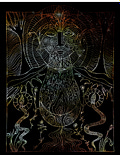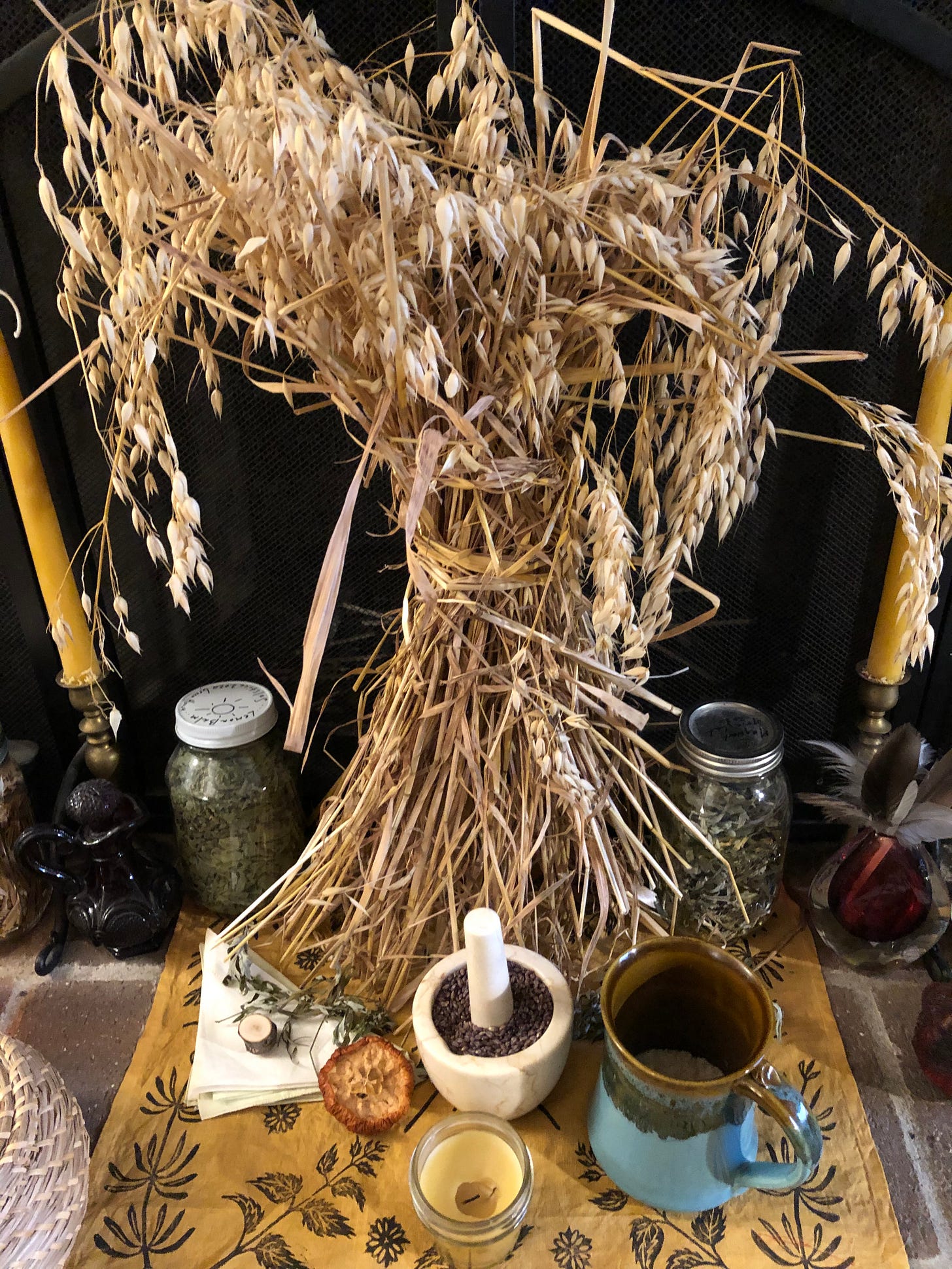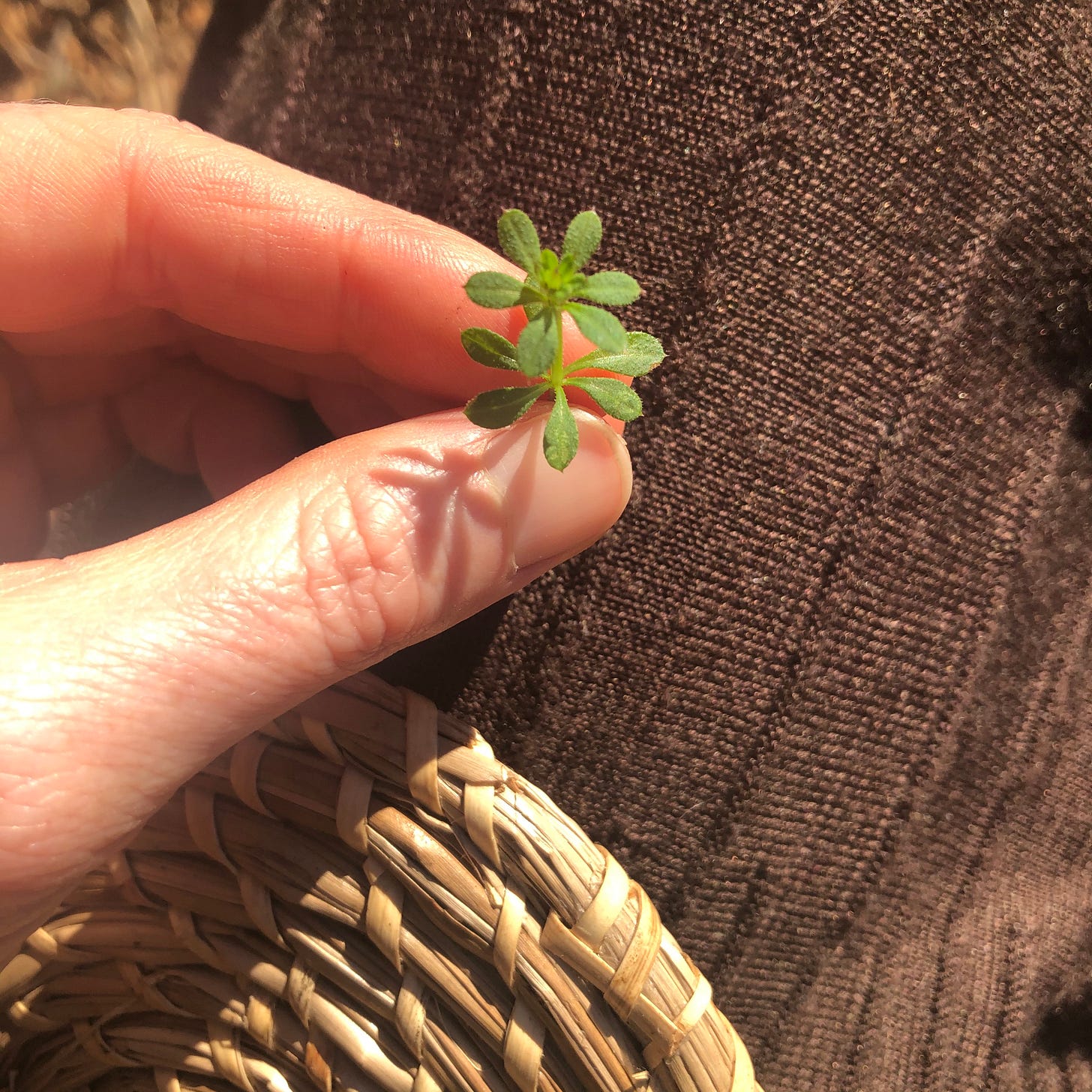Imbolc and Brigid: Rituals for New Beginnings
Seasonal inspiration, new sacred art and planting intentions.
Dear Ones—Here in the Pacific Northwest the red currant buds are thickening, new seeds crack beneath warming soil and the days lengthen. The garden calls for pea planting, and when I bend to earth a tiny wren flies near me, singing. All of these signs pull me to the round, they ask: Where were you at the mirror quarter day?
Imbolc in my bioregion is the cross-quarter day between the winter solstice and the spring equinox, which reflects Lammas, the cross-quarter day between the summer solstice and the autumn equinox. In early August, Lammas reflects Imbolc. This season of spring beginning and planting reflects the season of harvest and autumn begun. So the things that we're doing right now in our lives and in our work and in our gardens are actually preparing the ground for harvest at the August cross quarter day. There is a beautiful unification in this as well, for we can feel the earth rhythms everywhere—these cycles of light and dark happening even as we continue to grow. Even though I live in the Northern Hemisphere, all of these practices have their reflection in the seasons before and the seasons ahead, and I hope you can find your root in them, wherever you are planted this year.
This time of year carried significance in all of my lineages—which is what I speak to, sharing my path. I always hope folks who have different lineages will find in the information I provide a “sacred key” or way in to discovering how their other ancestors celebrated the holy days. What do I mean by this? If there is something that has particular resonance for you (a song to Brigid, for example, or the symbolism of the snake) that resonance may be a place to begin research with lineages not mentioned here. How did your other ancestors approach the turning of the year, what foods did they raise, what can we know of their luni-solar ceremonies and calendars. There becomes a unification in ancestral animist practice—we are all descended from people of the sacred earth with traditions of food, cycle, honoring and celebration.
The moon of February was known as Sune-manoð or Sól-manoð in the Old Anglo Saxon calendar, “Sun moon,” referring to the lunar nature of the calendar and the feature of the month. Bede writes that it is the “month of cakes,” often taken to mean offerings were given. This is the moon where folk may have practiced the Charming of the Plow, a blessing and preparation for planting. We can find echoes of this ritual in the Aecerbot, or Field Blessing Charm, where bread, milk, oil and honey are all placed on the plow and ritually in the furrows of the earth. It is also the season of the Dísablót, or Feast of the Dísir, the ancestral mothers, sometimes celebrated in February, other times nearer to the Equinox in March, depending on the lunar calendar. Here we may draw parallels between offerings, cakes, fertility and a feminine focus in ancestral veneration.
Here in the Pacific Northwest new shoots of green emerge from the dark soil. And that green, that mantle of green, is representative of Bridget, or Brigid or Bride, who is the patron Saint of this time. She is also a very, very old pre-Christian goddess who has great significance in Ireland and Scotland and Wales. Currently, the 1st of February is celebrated as the day of St. Bridget. However, Alexander Carmichael says in the Carmina Gadelica that in the Highlands Brigid’s Day was still very much celebrated in the old way, on the 13th of February. As I love to say, the holy days are a season, not simply one day of celebration. There is a lot of evidence that the holy times were celebrated over many days and had a lot of ritual and a lot of different activities taking place because they were so important to the community.
These celebrations were setting the stage for the next season, each Feast a time of both thanksgiving, reflection and preparation. The Feast of Brigid was also called The Feast of the Maiden, of Melodious Bride of the Fair Palms. And there was a song of hers:
Thou Bride fair charming
Pleasant to me the breath of thy mouth
When I would go among stranger
Thou thyself wert the hearer of my tale
Bride is often seen as coming with her white wand, breathing life into the dead mouth of winter. And really this represents this great awakening that takes place from Imbolc until the spring Equinox. She presides over fire, art and all beauty beneath the sky and beneath the sea. On Bride's Eve, girls fashion a sheaf of grain into the likeness of a woman dress her with early spring flowers, such as primroses and snowdrops, along with crystals and shells. And then she's carried from house to house in a procession by young girls dressed all in white with their hair down, and they collect offerings from the community. Each household is expected to offer beautiful objects to the Bride, and mothers are expected to give out bannock cakes and butter. The procession ends in a gathering, where the girls eat sparingly of this feast, and then distribute the bulk of the feast to the poor women in the community.
The community procession is a young girl’s ritual, but the older women have their own ritual. They weave a basket called the Bed of Bride, and also make an effigy, often out of the Last Sheaf of the Lammas harvest, which is usually oats and is called the Cailleach, hag or old woman, feasted as an ancestor through the winter, and then one woman stands at the open door and she calls out, “Bride’s Bed is ready!”
And another woman answers with the door open to invite in the bride, “Let bride come in, bride is welcome.” And then they bring the effigy to the bed, lay on the bed and they give her a peeled wand, symbolic of justice, peace and purity. The wand is usually made of birch with the bark removed or broom, bramble or willow. Then the women level the ashes in the hearth, and in the morning, they look for the footprint of Bride in the ashes to show that she came and visited the house and gave them her blessing. And if they don't find a footprint, then they know they have to make a lot of offerings to her because otherwise she might be displeased.
There is also a relationship to the serpent on Bride's Day. The serpent emerges on the day of St. Bride, and and you have to sing to the serpent:
Early on Bride’s morn
The serpent should come from a hole
I will not harm the serpent
Nor will the serpent harm me
Carmichael speculates that this comes from a very ancient kind of serpent reverence, a deep relationship between this ancient pre-Christian goddess or venerated mythic figure or ancestor, and the serpent who awakens on her day. The serpent in other verses is called a queen:
This is the Day of Bride
The queen will come from the mound
I will not touch the queen
The queen will not touch me
So February 1st is the Feast of Bride or Imbolc by the new calendar in Gaelic culture. In England, February 2nd is celebrated as Candlemas, the Feast of Mary of the Candles. And in Slavic cultures, February 2nd is called the Day of the Divine Thunder Candle, Mata Boska Gromniczna. This feast day also involves a processional, a purification and warding ceremony. The thunder candles are actually giant candles which households take to the church to be blessed and then bring home in lit procession. The lit candle is carried around the house and near the stable and near the livestock with this blessing, it's used to mark on the doorways across and then kept throughout the year and burned at times of thunder and lightning or times of danger and distress as protection.
We can see in this lore many unifiers. As we move into the season of Imbolc we can begin to explore some of these elements in ceremony and in our own lives. As an additional offering I have created an Imbolc ceremonial writing practice—available without a paywall on Patreon— for you to explore. Feel free to adapt as you need, and always you can incorporate any of the traditional quarter day practices as part of your ceremony.
This year I have crafted some devotional art to Brigid, the image that begins this writing. It is part of my Dísir series, celebrating the Ancestral Grandmothers in my lineage. It combines some of her symbols, the snakes and the Brigid’s Cross, as well as Neolithic symbols from the passage tomb at Newgrange, snowdrops and chickweed, some of the first flowers to emerge at winter’s end.
I draw in ceremony, and find it is helpful for me to have a mantra or prayer running through my mind while drawing. I found the following prayer-poem through St. Brigid of Kildare, an inclusive Catholic community in Canada, but found its author to be Caitlin Matthews. The poet Dorianne Laux once said that if you love a poem you owe it to the poem to memorize it, to take it into yourself, then the poem becomes a part of you, and you are part of the poem. I share it now, from memory:
Hearth Keeper’s Prayer
Brigid of the Mantle, encompass us
Lady of the Lambs, protect us
Keeper of the Hearth, kindle us
Beneath your mantle gather us
And restore us to memory
Mothers of our mother
Foremothers strong
Guide our hands in yours
Teach us how to kindle the fire
To keep it bright, to nourish the flame
Your hands upon ours
Our hands within yours
Tending the light
Both day and night
The Mantle of Brigid around us
The memory of Brigid within us
The protection of Brigid keeping us
From harm, from ignorance, from heartlessness
This day and night,
From dawn til dark, from dark til dawn.
Planting Intentions: News for 2023
A New Book
This year begins with the ending of the Dark Goddess Project, and the incredible news that my proposed book—the cumulation of they past year’s writing—has been accepted for publication! For those who have been walking with me a while, this is not the hand drawn guide to death transitions—that book is made of time (slow work, handwriting :)) and still in process. This new one will be typed and based in the curriculum of the Dark Goddess work, along with stories and other weavings. It has been a journey, this time of ceremony and self-initiation, course creation, community weaving, letter writing and story sharing. I’ll be sharing more in the moons ahead, but for now am on deadline to deliver the manuscript for Dark Goddess: The Art of Self-Initiation this March.
The Dark Goddess Project 2022 Concludes
The Dark Goddess Project—a year long rite of passage process—contained two components: one synchronous cohort who participated in a correspondence course through the year, and an asynchronous-nonlinear collective participating online. Each section had gatherings through the year and concludes with a rite of passage ceremony. The cohort concluded at Yule, and the online community’s rite of passage ceremony is at Imbolc. Please join me in wishing congratulations on all who participated in the project this past year!
Coming Soon: Wild Soul School Study Paths
There will be some big changes at the Wild Soul School this year, along with new class offerings and I’ll be announcing both after the equinox. Based on student input I am currently developing proposed courses of study for folks who have specific interests, offering suggested sequencing for some of the nonlinear courses to give a firm foundation in ritual practice, ancestral animist awareness, mythwork and more. Coven Invisible patrons have access to all asynchronous Wild Soul School classes as part of their membership, which can feel overwhelming. I am giving thought to progression, courses building on each other, and look forward to sharing more soon.
Current Resources and Inspiration
This year I would like to share what is inspiring me this season. Here are some of the things that are delighting me, and links to things I am finding fascinating or enjoying exploring. (None of these are commercial/affiliate links, just things I love and want to share.)
Urban Wildlife and Gardens
Nourishing the wildlife in my urban yard is a deep and perpetual source of joy. Right now I have over ten different kinds of birds congregating and scratching beneath the elderberries and artichokes. Over the past four years I have sheet mulched all the lawn on this lot and planted trees, PNW native plants, herbs, vegetables, and what was once hard pan soil with scrappy cheat grass is now full of life.
I’ve learned a lot about permaculture from Toby Hemenway, whose book Gaia’s Garden: A Guide to Home Scale Permaculture was my first on the subject back in my first days of city living.
I’ve also been very inspired by fellow Portlander Marisha Auerbach of Permaculture Rising. She offers a lot of education around permaculture, including (my preference) articles and videos on her website.
And I am forever indebted to Charlene Murdock of Foodways at Nana Cardoon whose commitment to our local food system enlivens me always and whose sanctuary of an urban farm offers education and peace to so many.
Inspiration for the Brigid Portrait
Whenever I draw I like to go deep into ritual and create a history bridge through research, and ultimately I find myself again and again symbolically in the Neolithic. For the portrait that begins this letter I started with St. Brigid of Kildare, flowing through the layers of time into the Goddess Brigid, and deeper still into the barrow mounds. The symbolic stones of Newgrange have been a particular influence for me over the years. This virtual tour allows you to enter the tomb and move through the barrow—it is so powerful!
I also discovered George Bain’s art working with the Pictish stones through the Groam House Museum, which is a wonderful resource for the history and symbols of the Picts.
We’Moon Calendars + Snake and Snake
For the past twenty plus years my annual treat to myself has been lunar calendars—I am a Moon Diva after all—for tracking my cycles and aligning with the moon. I am moving more away from the digital and have found a return tactile, tangible calendars helpful in orienting my rhythm. The We’Moon is on my desk, and the Snake and Snake single sheet of moon cycles lives in the bathroom. This past year I have encountered so many women wanting to align with the moon. And aside from going out to greet the moon each day or night (which I also do) these calendars offer an internal source for rooting into the lunar. Apps take me away from my body, but art brings me more into relationship.
I usually buy both of these at the co-op but this year I was too late. Happily though they are available online through Snake and Snake Productions. Artist Susan Baylies also has a Goddess Gallery and fun list of links.
***
Thank you, dear community, for reading this long letter!
I am so grateful for you support and this opportunity to share the path with you. May the blessings of this season find you rooted and aligned with your own inspirations, with the possibility inherent in the sacred everyday, within this miraculous life.
With love—Lara
Works Consulted
All of the folklore above is in the common domain and available in the Carmina Gadelica by Alexander Carmichael. For further reading I also love the books The Gaelic Otherworld by John Gregorson Campbell, and Irish Folk Ways by E. Estyn Evans.






